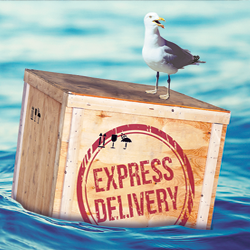|
REGISTRATION REQUIRED
exhibiting 101
 Trade Show Tune-Ups
A new build is an expense many exhibitors cannot afford. When your exhibit is looking a little worse for wear, try these budget-friendly stopgaps.
In a perfect world, exhibit managers
would have the budgets for a brand-new stand every couple of years. And while EXHIBITOR's 2017 Economic Outlook Survey found that half of respondents had at least tentative plans to purchase a new exhibit in 2017 (and 26 percent reported having definite plans to do so), the rest of us must make the most of what we have – and find wallet-friendly fixes where we can.
If you've been tasked with giving your used and abused workhorse exhibit a face-lift so that it can limp through another year, here are my tips, which I like to call my five R's, for keeping your trusty stand show-ready. Routine Maintenance It's almost impossible to avoid normal wear and tear, regardless of how carefully your exhibit house packs your properties or how diligently your installation-and-dismantle crew and booth staffers handle the components. So your exhibit is probably going to get a few bumps and bruises on its way to and from the show floor. The key to keeping an exhibit in perfect form is identifying potential issues early and often. First, ask your I&D crew to point out any repairs that can't be accomplished on site and/or during installation. These repairs can be noted on the master blueprints and with photos that can be emailed to you. Then, share the photos with your exhibit house. Second, schedule a visual inspection by your exhibit house as soon as the booth arrives after a show but before it is placed in storage. That way, any repairs, cleaning, or touch-ups can be made at a more leisurely pace – and hopefully not at rush or overtime rates – rather than waiting until the exhibit needs to be shipped to the next show. These types of minor repairs can include things such as fixing doors that don't lock properly or addressing laminates that are chipped, loose, or bubbled. If you have tensioned-fabric walls or hanging signs, have the integrity of the seams inspected for areas that may have been overstretched. Your exhibit house can also inspect and clean your carpet before it goes into storage, giving it plenty of time to dry in its warehouse and preventing delamination of the backing. Have any mounted graphics checked for dog-eared edges that need to be trimmed or replaced. Also take a good, hard look at your shipping containers. When the wooden planks (aka skids) fall off crates or rolling cases lose their wheels, your exhibit becomes susceptible to damage. Inspecting the inside of your crates and cases is important, too, especially if they contain jigging that secures your exhibit components or foam lining to protect audiovisual equipment. If the needed repairs go beyond replacing wheels and adding new skids, then consider purchasing new crates and cases. The cost of replacing them can be far less than the price of a new exhibit. Refresh What You Can Not every scrape and scratch warrants a trip to the exhibit house for repairs. In fact, you can fix minor damage to your exhibit structures on site – as long as you have a well-equipped gang box. For cosmetic fixes, I pack touch-up paint, small paintbrushes, and Q-tips. Before each show, I check my touch-up paint to make sure it hasn't dried up and turned to stone. If you don't have paint, pack some Sharpie markers that match the laminate and/or wall panels in your exhibit. They come in nearly every color under the sun and make for a quick fix on the go. Sometimes, an exhibit isn't banged up so much as it is dirty. To clean up laminates, I use any kind of "goop" remover I can get my hands on, such as WD-40, along with no-scratch sponges. I like Mr. Clean Magic Erasers as long as you have access to water, since they need to be damp to work. These items will take care of any leftover adhesive from hook-and-loop fasteners. Other must-have supplies include no-streak cleaners, polishers, and lint-free rags. I'm a fan of aerosol cans (such as Sprayway Glass Cleaner) that won't spill in the gang box and Novus polishing products that work on buffing scratches out of plastics, laminates, and acrylics. When it comes to booth carpet, I recommend packing some Folex Carpet Cleaner and a few small terry cloth towels. This combination will also work to remove spots on any fabric furniture. I also pack a 10-inch wide lint roller with a 3-foot extendable handle that picks up just about anything. My favorite is the Evercare Mega Cleaning Roller, which won't get you in trouble with the union that claims jurisdiction over vacuuming. And don't forget a long-handled antistatic duster for the dust that clings to your exhibit, especially after the aisle carpet has been laid. Refurbish Key Elements If your exhibit needs more than a trimmed dog-ear here or a colored-in scrape there, then it's time to consider refurbishment. Refurbishing an exhibit property doesn't necessarily mean a major makeover or overhaul, but generally includes changes or additions that will increase the functionality or enhance the look of the structure. Brainstorm with an exhibit house to determine improvements that fit your current exhibiting strategy and budget, and keep in mind that not all the changes have to be made at once. Rather, they can be rolled out in phases as your cash flow and show schedule allow. Some modest modifications might include replacing older halogen lighting with cooler and more energy-efficient LEDs, switching out stem lights for backlit fixtures, adding lights to hanging signs for increased visibility, updating corporate ID headers or product signage on kiosks, and upgrading furnishings in meeting rooms, theaters, and conversation areas. If you need something more extensive due to a corporate merger, rebranding initiative, product launch, etc., consider changing the color scheme of your exhibit, including carpet, walls, graphics, and hanging signage. You can also make a big visual impact by ditching heavy wood wall panels in favor of framed fabric where possible, placing stretchy fabric covers over existing panels, refacing hard walls with new laminate, or covering them with applied digital graphics, vinyl, or fabric. Assuming you have the funds, add new elements such as touchscreen kiosks, meeting rooms, storage areas, product displays, or even an upper deck, and replace static graphics with digital graphics on flatscreens. Finally, don't forget the flooring. For an easy update, swap out worn carpet for new wood laminate or vinyl. Reconfigure Your Layout You can literally think outside the box when you reconfigure the shape of your booth and the exhibit properties within it. Consider this an opportunity to have fun working with an exhibit designer while looking at the exhibit components you already own. I confess that I love rearranging the furniture in my home and office, so moving exhibit properties around to improve functionality, traffic flow, and eye appeal is sort of second nature to me. Simply repositioning your current components and possibly adding a few purchased or rental pieces on an as-needed basis can give you an exhibit that can adapt to changing booth sizes and markets. Another option is breaking up your booth space's square footage into smaller, separate stands. Let's say you currently use a 20-by-40-foot booth-space configuration. You could split your exhibit properties into two 20-by-20-foot booths that are across the aisle from each other, possibly making one into a meeting area and holding a theater-style presentation in the other. If you decide to try this tactic, known as "cutting space," check with show management in advance to see if it will let you carpet the aisle between your cross-aisle exhibits in the same color to unite your spaces. Retire Your Exhibit And now for a last-resort "R." There may be times when nothing is going to bring your exhibit back to life, and someone just needs to bite the bullet and sign its death certificate. If your exhibit is 1) excessively bulky to ship, 2) heavy to dray in and out of the hall, 3) expensive to install and dismantle, or 4) gives the impression that your company is on its last financial leg, it's time to pull the plug. But don't despair – putting an old stand out of its misery just might breathe fresh air into your exhibit program. E  Candy Adams
Candy AdamsCTSM, CEM, CMP, CMM "The Booth Mom," is an independent exhibit project manager, trainer, speaker, consultant, and an Exhibitor Conference faculty member. CandyAdams@BoothMom.com
|
|
|
||||||||||||||||||||||||||||
|
|
||||||||||||||||||||||||||||
|
TOPICS Measurement & Budgeting Planning & Execution Marketing & Promotion Events & Venues Personal & Career Exhibits & Experiences International Exhibiting Resources for Rookies Research & Resources |
MAGAZINE Subscribe Today! Renew Subscription Update Address Digital Downloads Newsletters Advertise |
FIND IT Exhibit Producers Products & Services All Companies Get Listed |
EXHIBITORLIVE Sessions Exhibit Hall Exhibit at the Show Registration |
ETRAK Sessions Certification F.A.Q. Registration |
EDUCATION WEEK Overview Sessions Hotel Registration |
CERTIFICATION The Program Steps to Certification Faculty and Staff Enroll in CTSM Submit Quiz Answers My CTSM |
AWARDS Exhibit Design Awards Portable/Modular Awards Corporate Event Awards Centers of Excellence |
NEWS Associations/Press Awards Company News International New Products People Shows & Events Venues & Destinations EXHIBITOR News |
||||||||||||||||||||
|
||||||||||||||||||||||||||||






